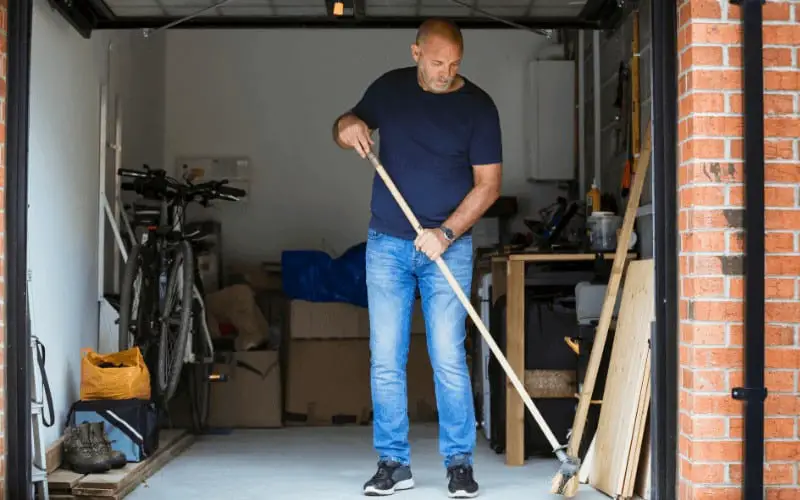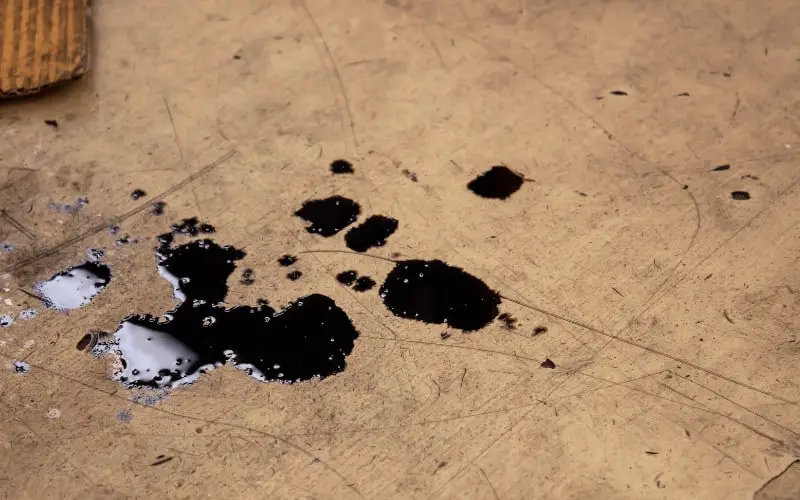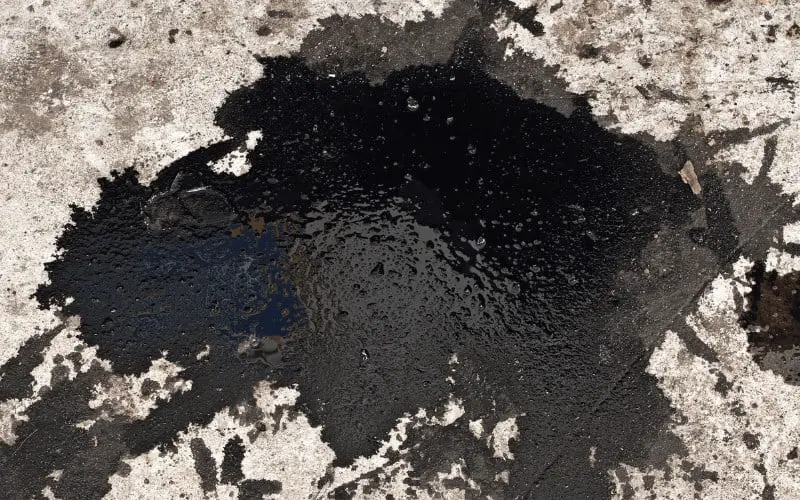If your vehicle just experienced an unexpected oil leak on your garage floor or you were probably working on the vehicle when it happened, an oil spill is something that every vehicle owner has to deal with.
An oil spill, especially on a concrete floor, needs to be attended to as soon as they occur to prevent the oil from sinking deeper into the porous concrete, so If you are looking for how to clean oil off garage floor, then keep reading.
How To Clean Wet Oil Spill Off Garage Floor
Table of Contents
As stated earlier, you need to tackle oil spills as soon as they occur because this makes the spill easier to clean and prevents it from leaving a stain behind.
Removing Oil Spill
To clean a recent oil spill, you will need some absorbent material like a paper towel or clean towels and a cleaning solution that is able to break down oil.
When a spill occurs, the first thing you want to do is take some paper towels and soak up any excess oil; you don’t want it to spread all over the area because that makes it difficult to clean.
You can also make use of cat litter, coconut husk, or sawdust to absorb the oil. Before using any oil absorbent, you want to always check the label for health and safety information.
If you are making use of cat litter, you need to make it is the clay litter rather than the clumping type that you are making use of, sprinkle the absorbent material of choice over the oil spill, and it sits for up to 2days if possible so that it will be able to draw out as much oil as possible.
Once the material has sat for a considerate amount of time, sweep it up and repeat the process if there’s still excess oil on the surface.
Once all the excess oil has been successfully soaked up completely, you need to go in with a cleaning solution in order to break down the oil and pull it out from the concrete. Liquid dish soap is highly recommended for this process as it is designed to cut through grease.
Read: Easy Homemade Floor Cleaner
So apply a generous amount of dish soap to the oil spill and let it sit for at least an hour; then, using a wire brush with stiff bristles, work the soap into the concrete and scrub it through-and-through.
To rinse, it is recommended to make use of hot water instead of cold water, so scrub the stain and rinse with some hot water; you want to be careful to avoid scalding yourself. Once you achieve your desired results, rinse the area, finally with some warm water, and allow it to dry.
Once the concrete surface has dried properly, you will be able to tell if you should repeat the cleaning process or not.
Remove Dry Oil Stains
If the oil spill has gone unnoticed for a long time, causing the oil to become dry on the surface, the cleaning approach will be quite different from that of the newly occurred spill.
With dried oil spills, you will need stronger chemicals, many of which are household remedies you can easily carry out.
Alkaline Degreaser
They are also known as concrete cleaner, and it is a type of powerful soap that can be gotten from any concrete distribution outlets. However, this product does not really work well on non-porous surfaces or if the area is heavily stained.
To make use of an alkaline degreaser, you have to first dilute it with water according to the package instructions. However, if you are dealing with a tough stain, you do not need to dilute it.
Apply the product generously over the stain and use a brush with firm bristles to scrub hard for a couple of minutes, then allow it to sit for a couple of minutes.
Finally, use rags or paper towels to blot the residue, and you can also make use of an industrial wet vac to remove the residue.
Mineral Spirits
You can also pour some mineral spirits on the stain and allow it to sit for at least three minutes before using a stiff-bristled nylon brush to scrub the area.
After giving the stained area a thorough scrubbing, you should lay some newspaper over the area and allow it to dry. Once dry, use one cup of bleach and one of laundry detergent, mixed into one gallon of warm water to wash the stain.
Using A Power Washer
You can actually use the high pressure of water to pull the oil out of the concrete surface. With a power washer, there’s no need for any cleaning solution or chemicals, and the cost of renting a power washer from your local plumbing shop is way less than you would spend buying detergents and chemicals.
For even stronger cleaning, you can add a power wash to regular other cleaning methods.
Before engaging in this procedure, you need to put on protective clothing like long pants, a long-sleeved shirt, goggles, and gloves; this prevents any of the chemicals you will use from coming in contact with your skin.
Then combine some laundry detergent with a powder cleanser in a bucket, add some water and mix thoroughly.
Before you apply this soapy mixture to the stained area, you need to give it a spray down with the pressure washer. Then apply the cleaning solution to the area and begin scrubbing with a stiff-bristled brush.
Allow the cleanser to sit on the stain for at least five minutes and then give the area a thorough pressure wash. This should lift up the stain and wash it away; you also need to give the area a final wash with a 25-degree nozzle. Then allow the area to dry before applying a concrete sealer to prevent future stains.
Read: Best Power Scrubber Review
Using An Enzymatic Or Microbial Cleaner
This type of stain remover uses micro-organisms to actually eat the oil and grease away, and it is one of the newest ways to deal with oil stain. They are very effective, especially if the microbial cleaner is formulated for the specific oil that was spilled.
You can get an enzymatic or microbial cleaner at any hardware or home improvement stores; you can also get it online.
To use any of this product, just apply the solution with a pump sprayer and let it sit for several days or weeks. You want to read the package instructions and follow it accordingly, some products require scrubbing, and some don’t.
You also need to find out from the package instructions for residue disposal options. Because they may or may not be residue left, and you want to make sure it is removed according to the manufacturer’s instructions.
As stated earlier, a general-purpose enzymatic degreaser works fine but getting a product specifically designed for the type of oil that was spilled works best.
Using Poultice
This is the last resort for very stubborn stains; this is a cost-effective option and removes tough and old oil stains effectively. However, mixing this solution for a large area can be quite tedious.
Before you get into mixing this product, you want to make sure you wear protective clothing, and the work area is properly ventilated.
You also want to read the solvent label for any safety instructions as Poultices contains hazardous solvents, which may be flammable, dangerous to inhale, or corrosive, so you need to be very careful.
You also need to Check regional laws or ask an environmental agency before ordering a solvent from another state or country because some chemicals like sodium orthophosphate (aka trisodium phosphate) might be banned in your area.
To get poultice, you will need to choose a solvent because poultice requires a solvent to be able to break down the oil. There are different solvents you can choose from;
- Acetone
- Lacquer thinner
- Mineral spirits
- 1 pound 6 oz (0.6kg) sodium orthophosphate in 1 gallon (3.8L) water
Directions
Turn the solvent of choice into a poultice by mixing it with an absorbent powder until you get a thick paste, similar in texture to peanut butter; they are different absorbent materials you can use, including;
- Baking powder, flour, or powdered sugar
- Kitty litter, diatomaceous earth, kaolin, or talc
- Whiting chalk or fuller’s earth
Once you’ve gotten poultice, you will need to test it out on a hidden area of the concrete; this is because most solvent has the ability to damage your concrete finish.
Apply a little amount of poultice to a corner and allow it dry, and check if it damaged the floor. If it did, you would need to mix up another poultice; if it doesn’t, you can continue with the process.
Apply the poultice to the stained area and spread the paste all over it. You want to cover the area with at least ¼ inch thick layer of poultice. Spread it all over the stain slightly beyond the edge.
After applying, you want to allow the poultice to sit on the surface from anywhere around 24-48 hours, depending on how long it takes the poultice to dry. But you want the drying time to be more than 24 hours; if the poultice gets dry before then, you will need to scrape it off and apply another layer of poultice.
Once the poultice has had enough time to sit on the stain, and it is dry, brush it with plain water and wash the dry poultice away; the residue of the poultice solution should all be disposed of properly according to local hazardous waste laws.
If, after washing away the poultice and there is still some stain left on the surface, you can go ahead and repeat the process.
Super Tip
- You can spread kitty litter over the garage floor if your vehicle leaks oil.
Conclusion
Oil stain on concrete floor can totally ruin the look of the surface, but the situation can totally be savaged. As stated earlier, cleaning up a spill immediately as it occurs is best as it helps to prevent the spread of the oil. So if you are looking for how to clean oil off garage floor, look no further.


